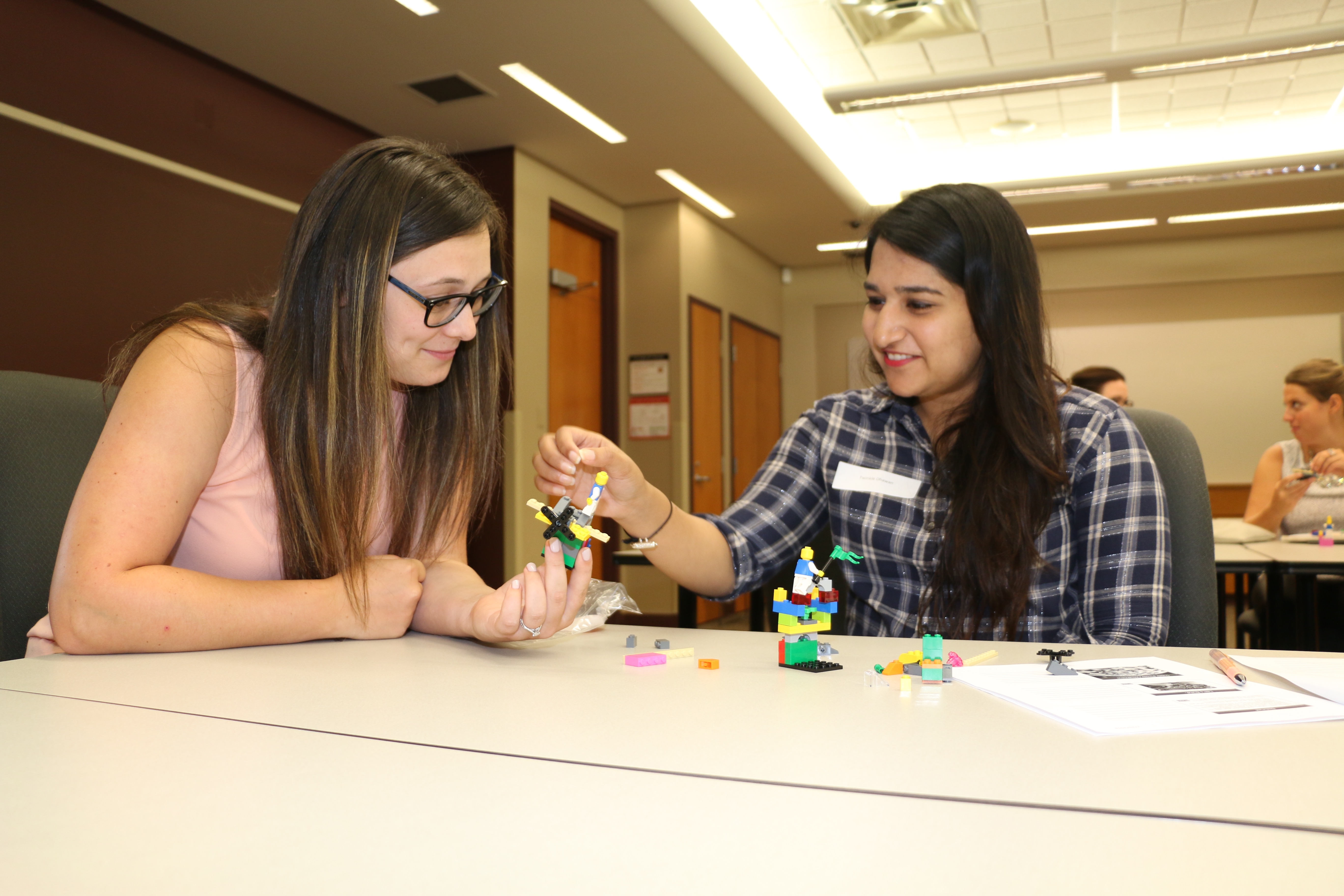
I took five popular career assessments and here’s what I learned
June 5, 2019
A musical approach to career assessment
June 5, 2019Brock University’s integration of gamification and assessment has helped students discover new insights about themselves
Marisa Brown
We didn’t start out with a comprehensive plan to gamify assessments with our students at Brock University. It just sort of happened.
We knew we wanted to increase student engagement in their career planning. We also wanted students to critically assess their own strengths, skills, competencies, work values, interests and other key elements in the career development process. Providing students with alternatives to traditional, formal assessments as part of their career journey was also a priority – we wanted them to have fun.
Around the same time, we invested in training a staff member in LEGO® Serious Play® – Methods & Materials facilitation. We were also considering how to incorporate images, mind maps and systems to support design thinking in our work with students.
What does it mean to ‘gamify’ assessments?
CERIC’s Glossary of Career Development defines self-assessment as the process of evaluating one’s own abilities, skills, values, interests and characteristics (CERIC and the Canadian Council for Career Development, n.d.). In the post-secondary context, this can be extended to students and the process of self-reflection in career discovery, career decision-making and career readiness.
Gamification in assessments means applying principles of game theory. According to Kapp and Coné (2012) – leaders in applying gamification within a learning context – a well-designed game involves abstract thinking, interactivity and is defined by a structure or set of rules. Players work toward a tangible outcome and the process may also elicit an emotional response as they strive to attain the goal. At Brock, we have aligned gamification principles to self-assessment by using a variety of tools to encourage abstract thinking and interactivity with the end goal of students discovering new insights about themselves and their career path.
Gamification at Brock University
Brock University has integrated LEGO® Serious Play®, mind mapping and SparkPath Challenge Cards into its career development toolkit.
LEGO® Serious Play® (LSP)
We use LSP with students as a tool for self-assessing strengths, values and skills. Our career consultants facilitate this process in a structured manner while also offering opportunities for abstract thinking (as in Kapp and Coné’s definition of gaming).
LSP is a facilitated technique that is grounded in four main phases: present the challenge, build a model reflecting the challenge (ie, add meaning to the LEGO® bricks), share and reflect. This process is repeated several times through a LSP session, resulting in deeper discussion and connection to the main topic or challenge. At Brock, we have facilitated LSP sessions in relation to skills identification, interview preparation, professionalism training and reflection.

Courtesy of Brock University
For example, in a recent interview-preparation workshop, we used LSP as a strength-based self-assessment tool. We asked students to construct a model of their strengths, skills or “superpowers.” In doing so, students analyzed their own abilities and made connections to how their strength translated in a work or academic setting. Reflecting on their strengths through LSP helps students develop answers to interview questions such as “tell me about yourself” and “what is your greatest strength?”
Students are often surprised at how the LSP process leads to generating new insights about their own strengths while also having fun “playing” with LEGO® bricks. They get genuinely excited about sharing their models with other students and feel more confident in expressing their strengths (than if they were to have done so without building their models first).
Students have also commented that they did not see themselves as creative until participating in LSP. They began to see themselves as creative thinkers through the process of building with the bricks. Students also expressed that they appreciated the opportunity to assess their current strengths in relation to career, rather than skills that they may use someday or have used in the past.
Through LSP, students engage in a continual reflection process and are more connected to the outcome – a physical LEGO® metaphor that they personally created. This complex, involved process can be more impactful than relying on a generated list of strengths or skills that is often a result of completing a more traditional assessment.
Read more about assessments and training opportunities on CERIC’s CareerWise website:
8 free career assessment tools to help clients find their fit
Mind maps
We also use mind maps as a way for students to identify and self-assess skills and competencies. Through a guided process, students create mind maps of skills they have developed through experiential learning activities (including co-curricular and curricular learning experiences) related to specific courses, program areas or career pathways. They engage in abstract thinking by literally drawing connections from experiences to skills in new ways.
This process of skill self-assessment also offers an opportunity for students to identify potential gaps and areas for further growth (if they are unable to identify experiences related to specific skills in their discipline or career focus). Students have commented on how the mind-map exercise offers “a-ha” moments for them when sharing their maps with colleagues and telling the stories of how they have developed certain skills.
Tangible outcomes include the mind map, answers to interview questions, ideas for career decision-making and goal-setting.
SparkPath Challenge Cards
Another informal self-assessment tool we have been using to engage students in career discovery is SparkPath Challenge Cards. Each Challenge Card set contains 30 visually appealing cards representing challenges in the future of work in health care, technology, society, environment and the economy.
Our career consultants use the Challenge Cards in one-on-one coaching sessions to engage students in conversations about career options, areas of interest, likes/dislikes and values. This approach focuses on students identifying challenges, problems and opportunities (shifting away from a focus on specific jobs). Through the guided process, students prioritize areas of interest and are encouraged to self-assess and reflect on personal and professional values. By interacting in the process and “playing” with the cards, students develop an action plan for next steps in their career planning.
These tools align with our philosophy of career development at Brock. We provide students with the tools to be successful in a self-directed process. Our career development model is grounded in John Krumboltz’s (2008) planned happenstance theory and Jim Bright and Robert Pryor’s (2003) chaos theory of career development. We encourage students to be flexible and take manageable risks while also asking for help and staying organized through the process. By inviting students to actively participate in the self-assessments of mind-mapping, building metaphors through LEGO® Serious Play® and Challenge Cards, they engage more fully in their own career decision-making. Students are engaged in the process of learning and developing their own narrative, which, according to Kapp and Coné, are critical elements of gamification.
Where we go from here
Our next steps include evaluating how impactful these activities are three months out and also in the longer term. We will be investigating how students are applying these concepts in future career and professional decision-making and how the tools have supported their career journey and self-exploration.
Marisa Brown is a Career Curriculum Specialist with Co-op, Career & Experiential Education at Brock University. She is a LEGO® Serious Play® – Methods & Materials facilitator, career development practitioner and holds a Master of Education – Teaching, Learning & Development.
References
CERIC & the Canadian Council for Career Development (n.d.). Glossary of Career Development. Retrieved from ceric.ca/glossary-of-career-development
Kapp, K. & Coné, J. (2012). What every chief learning officer needs to know about games and gamification learning. Institute for Interactive Technologies. Retrieved from karlkapp.com/wp-content/uploads/2013/01/clo_gamification.pdf
Krumboltz, J. D. (2008). The Happenstance Learning Theory. Journal of Career Assessment, 17(2), 135–154. doi:10.1177/1069072708328861
Pryor, R. G. L., & Bright, J. (2003). The Chaos Theory of Careers. Australian Journal of Career Development, 12(3), 12–20. doi: 10.1177/103841620301200304
Waggoner, D.R., Martin, S.J., Eads, J.L., & Branson, R.D. (Feb 2019). Using an Escape Room as Gameful Training with Students. NACE Journal. Retrieved from naceweb.org/career-readiness/competencies/using-an-escape-room-as-gameful-training-with-students/

